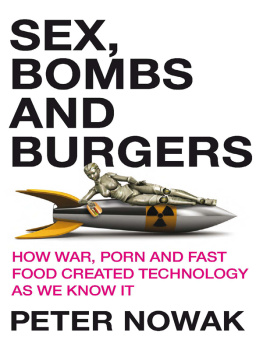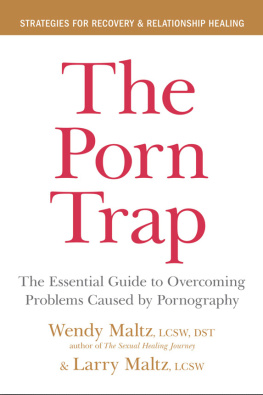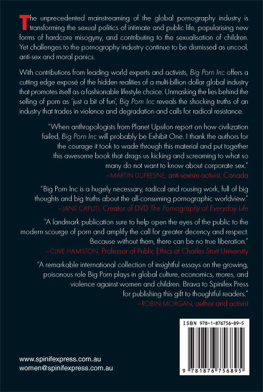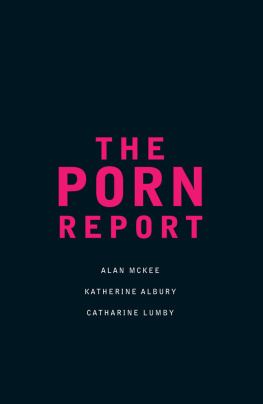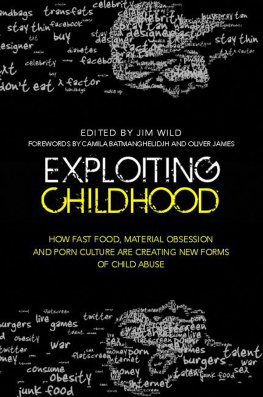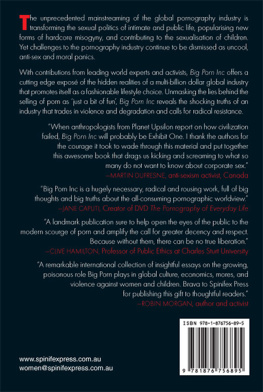SEX,
BOMBS
AND
BURGERS
SEX,
BOMBS
AND
BURGERS
How War, Porn
and Fast Food
Created Technology
As We Know It
Peter Nowak

Authors Note: The authors views and opinions are not necessarily shared by
the interview subjects or their organizations and companies.
First published in Australia and New Zealand by Allen & Unwin in 2010
First published in the United States by Penguin Group in 2010
Copyright Peter Nowak, 2010
All rights reserved. No part of this book may be reproduced or transmitted in any form or by any means, electronic or mechanical, including photocopying, recording or by any information storage and retrieval system, without prior permission in writing from the publisher. The Australian Copyright Act 1968 (the Act) allows a maximum of one chapter or 10 per cent of this book, whichever is the greater, to be photocopied by any educational institution for its educational purposes provided that the educational institution (or body that administers it) has given a remuneration notice to Copyright Agency Limited (CAL) under the Act.
Allen & Unwin
83 Alexander Street
Crows Nest NSW 2065
Australia
Phone: (61 2) 8425 0100
Fax: (61 2) 9906 2218
Email: info@allenandunwin.com
Web: www.allenandunwin.com
Cataloguing-in-Publication details are available from the
National Library of Australia www.librariesaustralia.nla.gov.au
ISBN 978 1 74175 824 5
Printed and bound in Australia by Griffin Press
10 9 8 7 6 5 4 3 2 1

For Ian, Greg,
Richard and Charlie
CONTENTS

We are living now, not in the delicious intoxication induced by the early
successes of science, but in a rather grisly morning-after, when it has become
apparent that what triumphant science has done hitherto is to improve the
means for achieving unimproved or actually deteriorated ends.
ALDOUS HUXLEY
The inspiration for this book came from the unlikeliest of sources: Paris Hilton. I wish it was some deeper or more sophisticated source, like the many scientific journals Ive read, a PBS documentary Id seen or even Wired magazine, but nope. My muse, Im ashamed to admit, was a hotel heiress with no discernible talents.
It was 2004, at the very beginning of the young blondes meteoric rise to celebrity. The internet was aflutter with a video of Hilton, then twenty-three, having sex with her boyfriend, fellow socialite Rick Salomon. There was, as is usually the case with celebrity sex tapes, a debate over whether the video had been purposely leaked to raise Hiltons public profile. Regardless, it certainly succeeded in getting attention. The video intrigued me, not because of the sex or the celebrity-to-be, but because a good portion of it was green. The naked flesh on display was not a rosy pink, but rather monochromatic hues of emerald. This was, I realized, because the video had been shot in the dark using the cameras night-vision mode. While most viewers marvelled at Pariss, er, skills, I was interested in the technology being used behind the scenes. Welcome to the life of a nerd.
As a technology journalist, Im used to wondering whats under the hood, so to speak, and thinking about such cultural events in ways the non-technically minded, thankfully, never consider. When CNN trotted out the worlds first televised holograms during the 2008 American presidential election and compared them to R2-D2s projection of Princess Leia in the first Star Wars movie, alarm bells rang and led me to discover that they were in fact tomogramsthree-dimensional images beamed onto the viewers screen and not into the thin air of CNNs studio. Similarly, most people enjoy Lego toys for their simplicity. Me? I couldnt help but wonder how designers decided on the optimum number, shape and variety of pieces in each set. So I called them to find out. It turns out that there are a lucky group of Lego employees who test-build sets, using three-dimensional modelling software to create new pieces as they are needed. The software also prices the sets based on the number of parts, so designers can add or subtract pieces to get the kit to their target cost.
Such are my nerdy preoccupations; these are the stories I write in my daily life as a journalist.
I knew I had seen Paris Hiltons night-vision technology before. The notion nagged at me for days before it finally hit: the first Gulf War, also known as Operation Desert Storm. More than a decade earlier, a coalition of countries led by the United States had gone to war to liberate Kuwait from a brash takeover by Saddam Husseins Iraq. I was too young for the televised reports of the Vietnam War so Desert Storm was the first big military action I had seen, played out on CNN as it was. The images that defined the war for me were the nighttime bombing raidsthe barrage of anti-aircraft fire arcing upward, followed by huge explosions on the ground. Like the sex video, the most memorable images of Iraqs defeat were, for me, bathed in green.
It got me wondering what other consumer technologies are derived from the military. The more I delved into it, the more I found that just about everything is. From plastic bags and hairspray to vitamins and Google Earth, military money has funded the development of most of the modern items we use today. I also found many other links between war and the technology used in pornography, which is basically what Pariss video was. The porn industry has been quick to adopt every communications medium developed by the military, from smaller film cameras to magnetic recording (which led to VCRs) to lasers (which led to DVDs) to the internet. Porn companies jumped on these technologies well before other commercial industries, thereby providing the money needed to develop them further.
The technological savvy of these two industries should come as no surprise. Lust and the need to fight or compete are two of the most primitive and powerful human instincts. They are our basest needs, a duo of forces that drive many of our key actions. Despite centuries of trying to deny, avoid, cure or otherwise suppress these forces, we have so far failed to find any course of action other than satiating them. As a result, catering to these needs has become big business. And big business needs technology to stay current and competitive.
Of course, there is another powerful urge that drives us: the rumbling in our bellies. At about the same time as Paris was getting famous, I was just starting to read the labels on grocery store shelves. Like anyone entering that phase of life where the metabolism starts to slow downthe tardy thirties, as I like to think of themI was actually starting to care about what I ate and therefore becoming concerned about the amount of glucose, fructose, phosphoric acid, sodium hydrogen carbonate and other assorted chemicals I was putting into my body. If youve ever read those labels and come across ingredients you cant pronounce, youve probably realizedas I didjust how much technology goes into our food.
As eye-opening as this was, though, it really shouldnt have come as a surprise. Our need for food is the most elemental instinct of them all, trumping all others, because without food we simply cant survive. Its understandable then that throughout history, weve used every resource at our disposal to ensure we have enough food on hand. Food has always been linked to power, and thereby to conflict. Historically, he who has had the most food has typically had the most power. And the best way to create lots of food is through technology. Ultimately, the more technology you have, the more food you have and the more powerful you are. This doesnt just apply at a macro level, eitherin any society, a wealthy individual is a well-fed individual.
Next page
